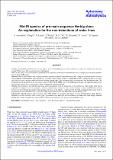Files in this item
Mid-IR spectra of pre-main sequence Herbig stars : an explanation for the non-detections of water lines
Item metadata
| dc.contributor.author | Antonellini, S. | |
| dc.contributor.author | Kamp, I. | |
| dc.contributor.author | Lahuis, F. | |
| dc.contributor.author | Woitke, Peter | |
| dc.contributor.author | Thi, W. -F. | |
| dc.contributor.author | Meijerink, R. | |
| dc.contributor.author | Aresu, G. | |
| dc.contributor.author | Spaans, M. | |
| dc.contributor.author | Güdel, M. | |
| dc.contributor.author | Liebhart, A. | |
| dc.date.accessioned | 2016-02-08T15:10:11Z | |
| dc.date.available | 2016-02-08T15:10:11Z | |
| dc.date.issued | 2016-01 | |
| dc.identifier | 240870679 | |
| dc.identifier | c2c43687-4ae6-4c2b-a41e-a7b27bb2042d | |
| dc.identifier | 84951765771 | |
| dc.identifier | 000369710300068 | |
| dc.identifier.citation | Antonellini , S , Kamp , I , Lahuis , F , Woitke , P , Thi , W -F , Meijerink , R , Aresu , G , Spaans , M , Güdel , M & Liebhart , A 2016 , ' Mid-IR spectra of pre-main sequence Herbig stars : an explanation for the non-detections of water lines ' , Astronomy & Astrophysics , vol. 585 , A61 . https://doi.org/10.1051/0004-6361/201526787 | en |
| dc.identifier.issn | 0004-6361 | |
| dc.identifier.other | ArXiv: http://arxiv.org/abs/1510.07948v1 | |
| dc.identifier.uri | https://hdl.handle.net/10023/8179 | |
| dc.description | The research leading to these results has received funding from the European Union Seventh Framework Programme FP7-2011 under grant agreement No. 284405. | en |
| dc.description.abstract | Context. The mid-IR detection rate of water lines in disks around Herbig stars disks is about 5%, while it is around 50% for disks around T Tauri stars. The reason for this is still unclear. Aims. In this study, we want to find an explanation for the different detection rates between low mass and high mass pre-main-sequence stars in the mid-IR regime. Methods. We ran disk models with stellar parameters adjusted to spectral types B9 through M2, using the radiation thermo-chemical disk modelling code ProDiMo. We explored also a small parameter space around a standard disk model, considering dust-to-gas mass ratio, disk gas mass, mixing coefficient for dust settling, flaring index, dust maximum size, and size power law distribution index. We produced convolved spectra at the resolution of Spitzer, IRS, JWST MIRI, and VLT VISIR spectrographs. We applied random noise derived from typical Spitzer spectra for a direct comparison with observations. Results. The strength of the mid-IR water lines correlates directly with the luminosity of the central star. The models show that it is possible to suppress the water emission; however, current observations are not sensitive enough to detect mid-IR lines in disks for most of the explored parameters. The presence of noise in the spectra, combined with the high continuum flux (noise level is proportional to the continuum flux), is the most likely explanation for the non-detections towards Herbig stars. Conclusions. Mid-IR spectra with resolution higher than 20 000 are needed to investigate water in protoplanetary disks. Intrinsic differences in disk structure, such as inner gaps, gas-to-dust ratio, dust size and distribution, and inner disk scale height, between Herbig and T Tauri star disks are able to explain a lower water detection rate in disks around Herbig stars. | |
| dc.format.extent | 13 | |
| dc.format.extent | 5985463 | |
| dc.language.iso | eng | |
| dc.relation.ispartof | Astronomy & Astrophysics | en |
| dc.subject | Protoplanetary disks | en |
| dc.subject | Line: formation | en |
| dc.subject | Stars: pre-main sequence | en |
| dc.subject | Circumstellar matter | en |
| dc.subject | QB Astronomy | en |
| dc.subject | QC Physics | en |
| dc.subject | NDAS | en |
| dc.subject.lcc | QB | en |
| dc.subject.lcc | QC | en |
| dc.title | Mid-IR spectra of pre-main sequence Herbig stars : an explanation for the non-detections of water lines | en |
| dc.type | Journal article | en |
| dc.contributor.sponsor | European Commission | en |
| dc.contributor.institution | University of St Andrews. School of Physics and Astronomy | en |
| dc.identifier.doi | 10.1051/0004-6361/201526787 | |
| dc.description.status | Peer reviewed | en |
| dc.identifier.grantnumber | 284405 | en |
This item appears in the following Collection(s)
Items in the St Andrews Research Repository are protected by copyright, with all rights reserved, unless otherwise indicated.

